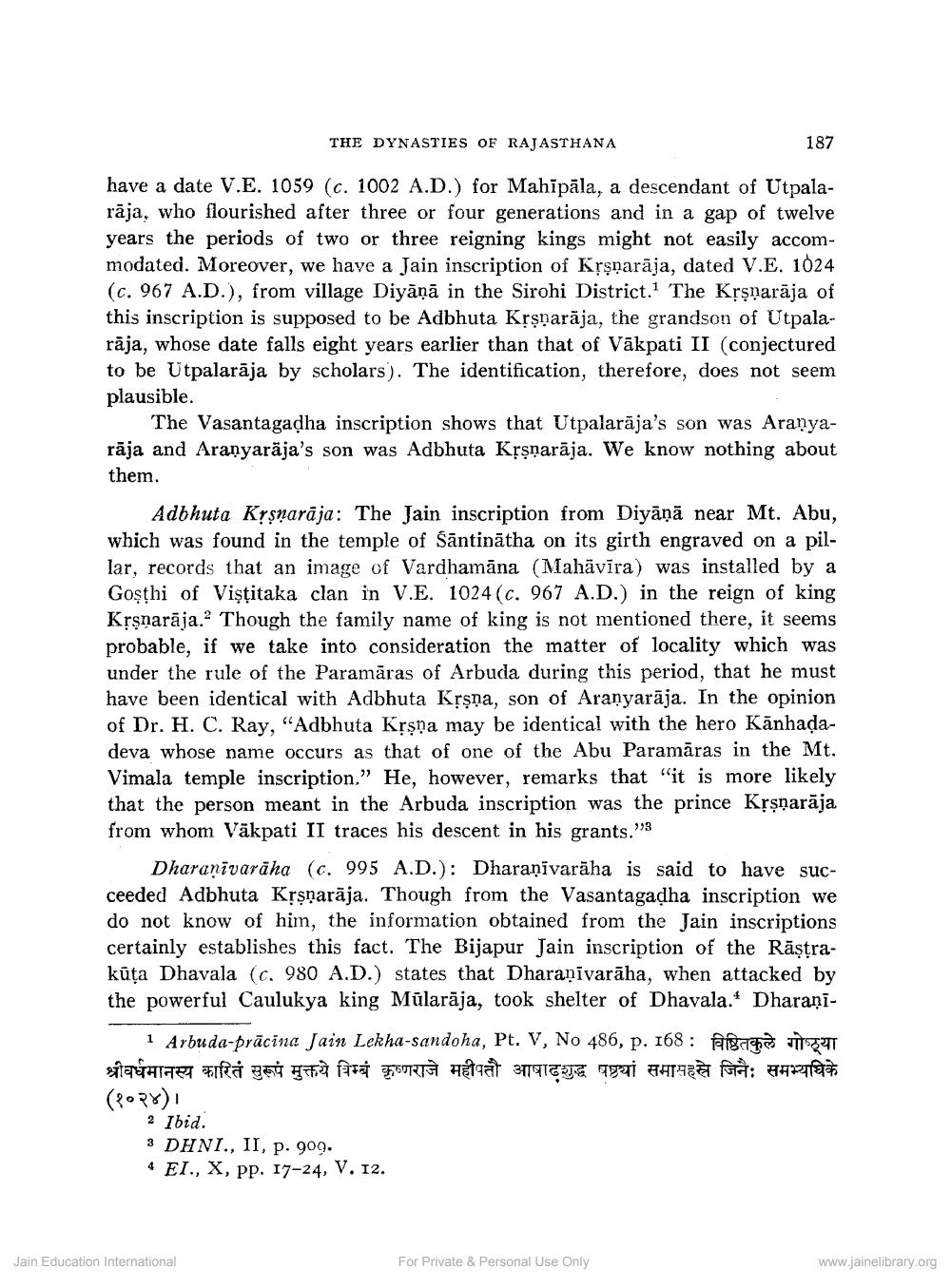________________
THE DYNASTIES OF RAJASTHANA
187
have a date V.E. 1059 (c. 1002 A.D.) for Mahīpāla, a descendant of Utpalarāja, who flourished after three or four generations and in a gap of twelve years the periods of two or three reigning kings might not easily accommodated. Moreover, we have a Jain inscription of Krşparāja, dated V.E. 1024 (c. 967 A.D.), from village Diyāņā in the Sirohi District. The Krşnarāja of this inscription is supposed to be Adbhuta Krşnarāja, the grandson of Utpalarāja, whose date falls eight years earlier than that of Vākpati II (conjectured to be Utpalarāja by scholars). The identification, therefore, does not seem plausible.
The Vasantagadha inscription shows that Utpalarāja's son was Aranyarāja and Aranyarāja's son was Adbhuta Krşnarāja. We know nothing about them.
Adbhuta Krsnarāja: The Jain inscription from Diyāņā near Mt. Abu, which was found in the temple of Sāntinātha on its girth engraved on a pillar, records that an image of Vardhamāna (Mahāvīra) was installed by a Gosthi of Vişțitaka clan in V.E. 1024(c. 967 A.D.) in the reign of king Krsnarāja.? Though the family name of king is not mentioned there, it seems probable, if we take into consideration the matter of locality which was under the rule of the Paramāras of Arbuda during this period, that he must have been identical with Adbhuta Krşna, son of Aranyarāja. In the opinion of Dr. H. C. Ray, "Adbhuta Krsna may be identical with the hero Kānh deva whose name occurs as that of one of the Abu Paramāras in the Mt. Vimala temple inscription." He, however, remarks that "it is more likely that the person meant in the Arbuda inscription was the prince Krşnarāja from whom Väkpati II traces his descent in his grants."
Dharanīvarāha (c. 995 A.D.): Dharaṇīvarāha is said to have succeeded Adbhuta Krsnarāja. Though from the Vasantagadha inscription we do not know of him, the information obtained from the Jain inscriptions certainly establishes this fact. The Bijapur Jain inscription of the Rāștrakūta Dhavala (c. 980 A.D.) states that Dharanīvarāha, when attacked by the powerful Caulukya king Mūlarāja, took shelter of Dhavala.“ Dharani
1 Arbuda-prācinc Jain Lekha-sandoha, Pt. V, No 486, p. 168: ABS TEST श्रीवर्धमानस्य कारितं सुरूपं मुक्तये विम्बं कृष्णराजे महीपतौ आषाढशुद्ध षष्ठयां समासहस्रे जिनैः समभ्यधिके (2078)
2 Ibid. 3 DHNI., II, p. 909. 4 EI., X, pp. 17-24, V. 12.
Jain Education International
For Private & Personal Use Only
www.jainelibrary.org




